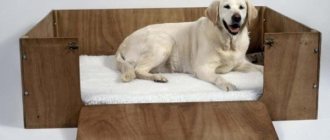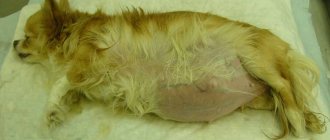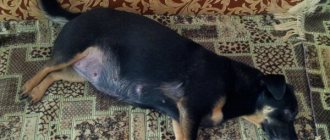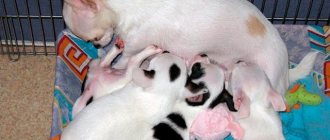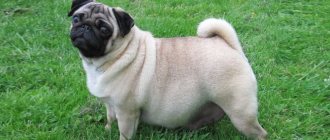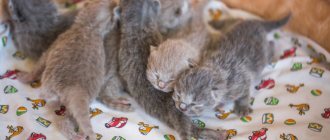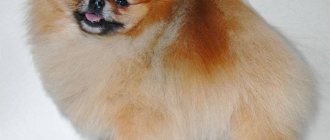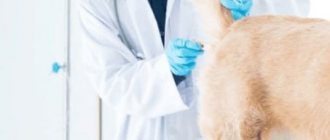The first birth of a dog is an important event both for the bitch herself and for her owner. In most cases, dog births take place with minimal human intervention, but still this matter should not be left to chance. If you study information about how childbirth occurs in dogs, you can recognize its first signs, assess the situation and understand whether the woman in labor needs to be assisted, or whether she can cope on her own. In order not to panic when the dog begins to give birth, to behave competently, you need to know how to deliver a dog at home.
How to prepare for the birth of a dog: what you need for childbirth
Before the first signs of labor appear in dogs, it is necessary to take care of what is needed for the dog to give birth. Be sure to prepare one large bar of chocolate, alcohol in a wide jar, synthomycin emulsion, hydrogen peroxide, white streptocide powder, about 20 gauze napkins approximately 6 x 6 cm and the same number of larger napkins, several large diapers and more small ones (the size of a napkin) for wiping the puppies and blotting the liquid, a shoebox with a heating pad (make the heating pad flat, letting out the air, and wrap it in a diaper - you will place the puppies on it).
Practical advice from a professional
- Start preparing for your dog's birth early.
- Feed your dog quality foods with vitamins and calcium.
- Study all the nuances of childbirth, read the necessary literature.
- If you are giving birth for the first time, then make a short printout that will serve as a teaching aid.
- Do not use medications without a veterinarian's prescription.
- Prepare the necessary tools, materials and preparations.
- Ask another family member to help you, it will be more convenient.
- Try to ensure that no one distracts you at this time, that children do not make noise, and that other pets do not scurry around under your feet.
- Don’t panic, because your feelings and experiences are transmitted to the dog.
Remember that you are responsible for your dog and for it you are the closest person in the world. Only you can she trust in the intimate moment of the birth of puppies. Approach the issue of giving birth to your four-legged friend responsibly and then everyone will be healthy and happy.
What is childbirth like for a dog (with video)
Below is a video of how dogs give birth at home:
It is better if the dog gives birth on the sofa or bed. Cover part of the sofa with oilcloth, put a large diaper and at the first signs of labor, place the animal there. When giving birth, the dog should lie on its right side. It is more convenient, first of all, for you to give birth on the sofa, since sometimes the process drags on for many hours - you need to help the dog and puppies, and it will be difficult to be on the floor all the time. Near the sofa there should be a table with everything you need, as well as a floor lamp or table lamp. The light should be bright. In between the births of puppies, the lights can be dimmed.
During the first stage of labor, the dog moans. The contractions become more frequent, which can be clearly seen in the abdomen - the uterus either tenses or relaxes. The dog's two-horned uterus, contracting, moves the puppy from the horn to the body of the uterus, and then to its cervix. This occurs during the first stage of labor, which lasts 12-24 hours. If these signs continue for more than a day or the dog, as it seems to you, has returned to the first stage from the second stage and is very suffering, you need to consult a specialist.
At the second stage of labor, the dog begins spasmodic movements, causing simultaneous contraction of the abdominal muscles and diaphragm - pushing. As soon as this stage occurs, a light (straw) colored discharge, the so-called fetal fluid, may appear from the vagina. The birth of a puppy can last up to 1 hour from the start of the second stage. The dog lies on its side or chest. Some squat as if wanting to urinate. This is what the dog does in the most difficult moments of expulsion of the fetus.
Sometimes a dark gray sac the size of a chicken egg appears from the vagina with fetal fluid. If the puppy inside cannot be felt, it must be cut with scissors. If a puppy is felt inside the sac, the membrane should not be damaged - this is the amniotic membrane with the puppy inside. The membrane may rupture before the puppy emerges.
Preparatory activities
Owners prepare well in advance for the birth of their beloved dog, two weeks before the expected date.
Place of stay
Arrange in advance the place where the “mommy” and the puppies will stay. For small dogs, a purchased house or a regular box with a roof and an entrance is suitable. Large dogs can actually build a box from scrap materials. For example, from boards or plywood and cover it with old blankets.
In any case, the “dog nursery” should be located in a secluded and safe corner, protected from drafts and irritating factors.
Newborn puppies are capable of crawling from the first hours of life, so the house for them should have sides and be equal in size to the size of the dog, multiplied by 1.5.
Maternity place
Don't forget to determine where the birth will take place. Small dogs can be conveniently placed on the table, while medium and large breeds of animals can give birth on the floor or on the sofa.
The place should be bright and warm, without drafts, room temperature +20 or +25°C. No strangers, children or other animals should be allowed in it. The mother dog should sniff it a few days before giving birth.
List of essentials
Write a list and take your time collecting dowry for the expectant mother and her puppies. In the prenatal bustle, it will be difficult to find everything you need. You will need:
- Bedding and oilcloth on which the birth will take place. An old sheet or towels will do. Keep in mind that you will need to throw it all away later.
- Sterile cotton diapers or absorbent fabric ones for drying puppies. They need to be ironed in advance and placed in a plastic bag.
- Trash can and bags.
- Disposable medical diapers that the puppies will wear for the first time.
- Hand sanitizer.
- A regular or electric heating pad for warming puppies in a box.
- Sharp scissors for cutting the umbilical cord. Before giving birth, they must be boiled, calcined over a fire or treated with alcohol.
- Tweezers for holding and clamping the umbilical cord.
- Silk threads for tying the umbilical cord.
- A thermometer, preferably an electronic one.
- Green paint and cotton swabs for processing the cut.
- Potassium permanganate for washing a woman in labor.
- The telephone number of a 24-hour veterinary service or a doctor ready to provide emergency care at home (just in case).
For long-haired dogs, before giving birth, the hair in the loop area, under the tail is trimmed and the belly is shaved.
Delivery of dogs at home
As soon as the puppy's head and paws appear, he should soon come out all over. If this does not happen, we need your help. The puppy's nose and paws appear and disappear only when the dog pushes. During pushing, when part of the puppy has appeared, you need to grab it with a gauze napkin and pull it towards the bitch’s belly, bending it. This makes it easier for him to come out and be born on his own.
If a puppy is born in the classic position, it walks nose first, with its front paws on either side of its muzzle. However, 30-40% of puppies are born seat first. This usually does not interfere with the normal course of labor. The puppy can walk with both its head and hind legs - both positions are considered normal.
Typically the bitch will rupture the amniotic sac, try to eat the placenta (don't let her do this!) and chew the umbilical cord. Sometimes primiparous and even some multiparous bitches do not do this. In this case, your help is needed, otherwise the puppy may die from asphyxia. First of all, you must rupture (or cut with scissors) the amniotic sac in the puppy's muzzle area, quickly freeing it from the membrane.
The puppy can still be connected to the mother by the umbilical cord. When giving birth to dogs, do not rush to cut the umbilical cord; this can be done later. Most often, the puppy breathes heavily, with sobs, and sometimes bubbles and mucus appear from his mouth and nose. Noisy, squelching breathing can be clearly heard. In this case, it is necessary to lower the puppy upside down (it must still be connected to the mother by the umbilical cord) and blot the cavity of the mouth with a gauze napkin wrapped around a finger.
If the puppy continues to breathe heavily (especially through the mouth), it means that he has swallowed amniotic fluid. In this case, you need to wrap your lips around his muzzle and suck out the liquid that may be in the bronchi and even the lungs. This must be done very carefully. Do not disdain this procedure - it is necessary to save the puppy’s life. In addition, it is completely sterile. The puppy must remain connected to the mother by the umbilical cord. If the mother continues to be inactive, give the puppy a good rub. In general, the more the mother moves and massages the puppy, the better. Don't stop her from doing this.
Host Responsibility
Childbirth for a dog is a natural process and on a physiological level it knows what to do in this case. However, there is no absolute guarantee that the animal will perform its duties well.
The reasons for this: the dog’s inexperience, rapid or sluggish labor, and a simple lack of desire to care for puppies. In this case, responsibility for the offspring falls entirely on the owner.
Not only the fate of newborn puppies, but also the life of an adult dog will depend on the coordination of actions and the speed of decision-making.
Puppies are not only funny faces and a way to earn extra money, but also a lot of worries, problems and responsibilities that will be associated with their birth.
It is important not only to become an obstetrician, but also to carry out preparatory activities, read a lot of materials, study all the details and nuances. It is possible that you will need to take time off from work while giving birth and caring for the puppies.
Try to attend an ultrasound 10-14 days before birth to find out the number of puppies in the litter, their location and possible pathology.
Childbirth in dogs: pulling out the placenta and breaking the umbilical cord
The next stage (if the mother does not do this) is pulling out the placenta and breaking the umbilical cord. The afterbirth is pulled out carefully - only by the flaps of the shell, in no case by the umbilical cord! It is better to do this with a gauze napkin - it does not slip. First you just need to fix the remains of the fetal membrane, then slowly, carefully, almost without effort, pull up the placenta.
After the placenta has passed, if the dog does not gnaw the umbilical cord itself, you should rub it with your nails with clean (moistened with alcohol) hands at a distance of 4-5 cm from the puppy’s belly. If the umbilical cord is bleeding, you need to squeeze it with your fingers and hold it for about a minute, then dip the cord in hydrogen peroxide and sprinkle with streptocide powder. After this, the puppy should be placed under the mother.
Count the placenta as the puppies emerge. Unreleased placenta most often comes out within a few hours or the next day. The bitch must not eat a single afterbirth! However, this recommendation is controversial. Many dog handlers insist on the opposite, appealing to the behavior of wild animals. It is believed that eating the afterbirth stimulates milk production.
The moment of expulsion of the fetus and the subsequent rest of the uterus represent the third stage of labor. During this period, the bitch is usually calm and completely occupied with the babies. Offer her a drink - tea with milk and sugar, if she refuses - clean water. There are cases (fortunately very rare) when a thirsty bitch can eat a puppy, so a bowl of water should always be nearby.
The rest period lasts from several minutes to several hours (usually no more than two). The birth of 4-5 puppies takes on average 6-8 hours. However, there are often cases when normal birth lasts longer - even up to 36 hours.
If the intervals between the birth of puppies are too long, and the bitch’s efforts are weak, under no circumstances immediately turn to stimulants (oxytocin, mammophysin)! This can lead to uterine rupture. Harmless and effective stimulants for sluggish pushing are a light massage of the dog’s abdomen, sides and back and cinnamon infusion (one teaspoon per glass of boiling water). The woman in labor is given 1-2 tablespoons of brewed and cooled infusion to drink. Chocolate gives the dog strength and, according to some reports, stimulates labor, pieces of which are offered to the dog throughout the entire period of pregnancy.
If the intervals between the birth of puppies are prolonged, it is good to let the dog walk around the apartment. She usually willingly leaves the place where she is giving birth. Take one puppy and the bitch will follow you. Most often, after this, the dog resumes labor. Cinchona preparations should not be given! This can lead to the opposite effect - completely stopping the attempts.
The last place of birth (afterbirth) often has an intense dark green color. Its release often indicates the end of labor. With the birth of the last puppy, the bitch usually immediately calms down and her behavior changes dramatically. She licks and grooms the puppies and herself.
What to do after giving birth to a dog: walking, feeding
When everything is over, you should try to take the dog for a short walk. However, she will not want to leave her babies, and for the first time she sometimes has to be taken out forcibly.
After a walk, you need to wash the contaminated areas well with soap, wipe the dog dry, and then let them go to the puppies, placing them in the place where they will be in the future. 8 hours after the birth of the last puppy, the bitch should be fed well-cooked rice with milk, sugar and butter. During the first three days after giving birth, the dog's diet should be fed with the same food that you gave it before whelping. You need to feed abundantly and often, and give sweetened tea with milk.
What medications and equipment are needed?
Before starting to perform the duties of an obstetrician, it is necessary to shorten your nails, wash your hands with soap, and disinfect them.
Before giving birth, prepare everything you need.
When your dog begins to give birth, you should have a standard obstetric kit on hand, including:
- sheet and oilcloth;
- heating pad;
- box for newborn puppies;
- two thermometers (room and medical);
- sterile pipettes, tweezers, scissors, syringes;
- a basin for dirty diapers;
- tray;
- cotton wool;
- sterile gauze wipes;
- silk threads (put in vodka or alcohol);
- soft diapers;
- watch;
- notepad with pen;
- small scales;
- multi-colored wool threads (to mark puppies).
You should also prepare medications:
- brilliant green;
- hydrogen peroxide;
- vodka or medical alcohol;
- glucose 5% in ampoules;
- traumeel.
Caring for your dog after birth
Caring for a dog after birth must be very careful, because the animal is still very weak and can sometimes behave inappropriately. In the first days after giving birth, the bitch still remains restless: sometimes she breathes frequently and heavily, sleeps little and fusses all the time with the babies. At this time, her body temperature may rise (up to 39.5 ° C). If there is a rapid increase to 40 °C or higher, consult a doctor immediately.
In the first days, many bitches become aggressive - they do not allow even the closest people near the puppies and may bite. As a rule, after a few days they calm down and allow you to take their babies.
During such a period, it can be difficult to lure the bitch out of the nest. In order for her to come out and you can take her for a walk, just ring the front door - she will run out to answer the bell.
Diseases of dogs after birth
Within 1-2 weeks, the bitch may have discharge - first red or brown, then bloody, mucous, sometimes greenish. If this period drags on and the discharge becomes purulent, the animal must be shown to a veterinarian.
One of the most dangerous diseases, which most often occurs in bitches that were improperly kept during pregnancy, is eclampsia, or postpartum tetanus. Attacks of the disease can sometimes occur during childbirth, but more often begin during the period of feeding puppies. The symptoms of eclampsia are as follows: the bitch becomes restless, trembles, breathes heavily, the conjunctiva of the eyelids and the inner surface of the mucous membrane of the lips turn pale, her gait becomes unsteady, her hind legs become tangled when walking, tic-like twitching of the muscles of the head occurs, and then convulsions that spread to the muscles of the trunk and limbs.
If urgent measures are not taken, the dog may die. Try to contact your veterinarian immediately. If this is not possible, then you can provide first aid yourself: give the dog 7-10 drops of Valocordin, then intramuscularly (into the thigh) inject 1.5 cm3 of novocaine and, without removing the needle, fill the syringe with 4 cm3 of calcium gluconate solution. After an hour, repeat the injections. Most often, as a result of these procedures, an attack of eclampsia can be stopped.
If the convulsive attack recurs, then after 4 hours do all the steps again in the same sequence. In this case, the puppies should be weaned from their mother and artificially fed (this will be discussed later).
Prevention of eclampsia is the correct maintenance of the puppy: good nutrition, mineral supplements (calcium salts), absence of protein-containing products 5-7 days before the expected birth and in the first 4 days of the postpartum period.
Often a dog will develop diarrhea after giving birth, which can be passed on to the puppies. The bitch should be given astringents - a decoction of pomegranate peels, oak bark, horse sorrel, blueberries, bird cherry, etc. It is also good to give jelly, rice decoction and add dry potato starch to the food.
The following products are lactogenic: raw meat, milk, cottage cheese, cheese, Hercules (has a laxative effect) and grated carrots with fat (sunflower oil and sour cream). Meat can be given earlier than the fourth day after whelping. During the feeding period, the bitch needs mineral supplements: glycerophosphate and calcium gluconate, gephefitin (0.5 tablets for each puppy and 1 tablet for the mother).
Often, in the first days after giving birth, bitches experience hardening of the mammary glands, especially the lower ones. It is necessary to place the strongest puppies on such nipples; If they still do not suck out the milk, you should express it until the gland softens, using a breast pump.
Caring for newborn puppies
Caring for newborn puppies is not as difficult as it might seem at first glance, but it requires your patience and a fair amount of fearlessness. If the puppy whines and worries, then most likely it is not from hunger. Most often, it is enough to empty his intestines of gases and feces. To do this, place the puppy on your left palm with its head up and empty the bladder by giving a light massage in the area of the urinary opening - after a few seconds the urine will pass out. Then massage the puppy's tummy clockwise, then around the anus and the hole itself. If the puppy has not recovered after this procedure, you can lubricate the ball of the eye scapula with any fat and carefully insert 5-6 mm into the puppy’s anus. Most often, these manipulations lead to the desired result: the baby calms down and begins to suck.
If the puppy was born weak and does not take the nipple, it should be placed on it, opening its mouth and at the same time squeezing milk out of the nipple. It may take time, but eventually he will start sucking on his own. A very weak puppy should be pipet-fed with his mother's expressed milk, or at least partially with it, alternating with formula milk.
If a bitch has given birth to many puppies and there are not enough nipples for all of them, you can divide them into two groups and place them under the bitch alternately every 2 hours (“resting” puppies should be placed in a cardboard box on a warm heating pad covered with a diaper).
Remember: for the first three days you need to constantly monitor the bitch and puppies. An exhausted dog, falling asleep, can crush the puppy. If you attach strips around the perimeter of the nest (10 cm from the litter), this danger will be minimized.
If the puppies are restless, squeaking, crawling in different directions, they are hungry. It is necessary to check whether the mother has enough milk; if not, then the main reason for its absence is its insufficient and inadequate feeding. Feed your bitch well and you won't have any trouble feeding your puppies.
Puppies are born blind and deaf. Only their taste and smell are well developed. They begin to hear after 6 days, insight occurs on the 11-14th day, teeth erupt after the 21st day. An indicator of slow development of a puppy is the absence of teeth, usually in the lower jaw, by the 30th day. In this case, the commission that examines the puppies may rate the litter a lower score.
Puppies of certain breeds have their tail docked on the 3-5th day. It is better if a club specialist does this.
Cubs aged 10 and 20 days need to have their claws trimmed and their front paws well treated with a nail file.
